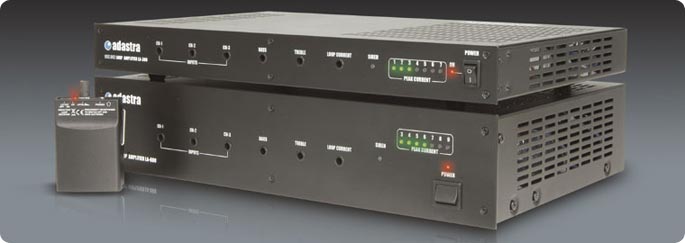
It is estimated that approximately two million people in the UK have hearing aids that are capable of receiving audio frequency induction loop transmissions.
Inductive loop amplifiers are a must for modern PA installations to give equal access to information and announcements to people with hearing disabilities. The Disability and Discrimination Act (1995) states that it is unlawful for service providers to discriminate against disabled people by providing them with a lower standard of service, or service on worse terms for reasons relating to their disability.
Adastra's two new induction loop mixer amplifiers are designed to complement the 900 series mixer amplifiers with their, much celebrated, multiple input options; allowing these induction loop amplifiers to be used, stand alone, with up to three sound sources - no need for a separate mixer or mixer amplifier.
The amplifers are available in two versions:
Each amplifiers features 3 inputs accepting input via XLR, 6.3mm Jack or RCA Phono with inputs switchable between mic and line with optional phantom power switchable on the rear panel. Tamper proof input level, bass & treble and loop current controls (recessed and adjusted by screwdriver) ensure that you can set up the system to suit the venue and there is even a built-in alarm circuit for evacuation alerts.
Induction loop amplifiers allow audio signals to be transmitted using a magnetic field to a suitably equipped listener. A magnetic field is created when current flows though a wire - in induction loop systems the wire is normally installed as a loop around the perimeter of the area. A small coil within a hearing aid or other suitable receiver then receives this magnetic field and converts it to audio at a suitable level for the listener.
The loop itself is simply an insulated wire installed at a low level, around the skirting board for example.
Hearing aids designed to receive induction loop signals generally have a switch marked 'M' for microphone and 'T' for telephone (Sometimes a combined position is provided). In the 'T' position a pickup coil, originally designed for picking signals from a telephone earpiece, is used to receive audio from induction loop systems.
The ideal signal strength for an induction loop system is such that a person switching between 'M' and 'T' would not notice a difference between the sound of someone speaking normally and a signal transmitted from the loop. To help in determining the perfect level it is often a good idea to engage the services of a hearing aid user - after all they are the ones that the system will most benefit. We also have available a simple inductive loop receiver that allows you to listen to the loop signal using an ordinary pair of headphones.
It is important for the cable used to form the loop is capable of carrying the current that the amplifier produces. The table below is a guide to the maximum loop length for each cable thickness.
| Cable Ø | 1.0mm² | 1.5mm² | 2.5mm² | 4.0mm² |
| Total loop length | < 60m | < 110m | < 200m | > 200m |